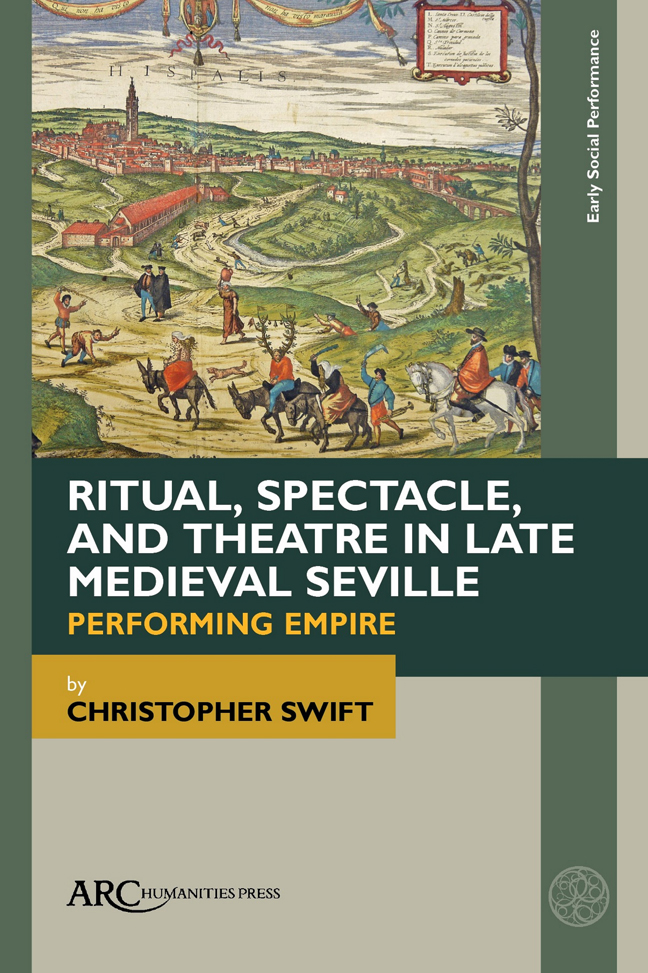Book contents
- Frontmatter
- Contents
- List of Illustrations
- Abbreviations
- Notes
- Acknowledgements
- Introduction. Theatres of Absence
- Chapter 1 The Cantigas de Santa Maria: Theatrical Acculturation of the Andalusi Colony
- Chapter 2 Penance, Conversion, and Affective Convivencia
- Chapter 3 Strange Infidels in the Imperial Metropole
- Conclusion. Walking Ghosts
- Bibliography
- Index
Introduction. Theatres of Absence
Published online by Cambridge University Press: 22 February 2024
- Frontmatter
- Contents
- List of Illustrations
- Abbreviations
- Notes
- Acknowledgements
- Introduction. Theatres of Absence
- Chapter 1 The Cantigas de Santa Maria: Theatrical Acculturation of the Andalusi Colony
- Chapter 2 Penance, Conversion, and Affective Convivencia
- Chapter 3 Strange Infidels in the Imperial Metropole
- Conclusion. Walking Ghosts
- Bibliography
- Index
Summary
…ninguno puede ver las cosas que en él se muestran, que tenga alguna raza de confeso, o no sea habido y procreado de sus padres de legítimo matrimonio; y el que fuere contagiado destas dos tan usadas enfermedades, despídase de ver las cosas, jamás vistas ni oídas, de mi retablo.
BEST KNOWN FOR the novel Don Quixote, Miguel de Cervantes Saavedra also wrote for the stage. His short, comically dark play El retablo de las maravillas was published at the end of the period of the expulsion of Moriscos from Spain (1609–1615) and offers us a theatrical portal for viewing imperial Spain during the centuries prior to el Siglo de Oro—the Spanish Golden Age of literature, art, music, and theatre. El retablo is a play about a puppet show, or more precisely, a puppet show that never takes place. The theme of the entremés is based on an exemplar from the fourteenth-century collection of stories known as El conde Lucanor (Count Lucanor) and appears again in Kejserens nye klæder (The Emperor's New Clothes) by Hans Christian Andersen. The literary and dramatic lineage of the picaresque tricksters in the play can be traced farther back, to eleventh- and twelfth-century maqāmā stories and shadow puppet theatre in al-Andalus, and across the wider Arabic-speaking world. The mordant plot involves two travelling rogues, Chanfalla and Chirinos, who swindle a gullible, anxious group of villagers out of six ducatos by promising to present a spectacle that can be seen only by Old Christians, that is, Christians without Jewish or Muslim ancestry. The con artists narrate the Old Testament story of Samson's destruction of the temple; however, el retablo (the puppet stage) remains void of action. Out of fear of being identified as Conversos or Moriscos, the townspeople feign reactions as they gaze upon the empty stage. In the last moments of El retablo, the theatrical trick turns deadly. A soldier who admits to seeing nothing becomes enraged when he is accused of being “one of them.” He slaughters the audience of townspeople.
El retablo summons not only an empty stage but historical absences as well: forced conversions, expulsions, and massacres of non-Christians over a two-century period preceding the publication of the play. Cervantes's satire of the blood purity anxieties of late medieval and Counter-Reformation Spain reveals the theatrical nature of ethno-religious identity, a theme that is explored in this book.
- Type
- Chapter
- Information
- Ritual, Spectacle, and Theatre in Late Medieval SevillePerforming Empire, pp. 1 - 28Publisher: Amsterdam University PressPrint publication year: 2023



